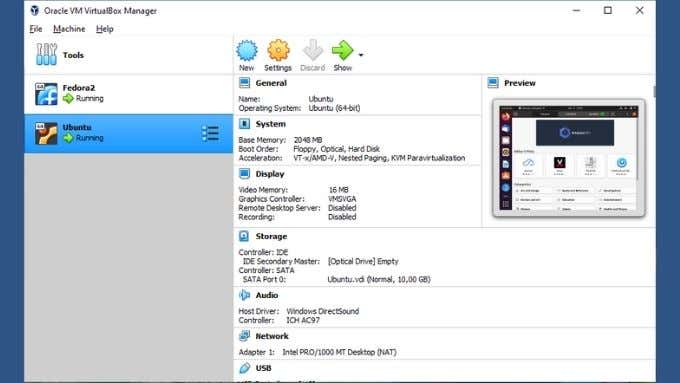However, right now Ubuntu and Fedora Linux are two of the most popular options for desktop operating systems based on the Linux kernel. The question is which one is best for you?
Fedora Vs. Ubuntu: Different Branches on the Family Tree
The biggest fundamental difference between Fedora and Ubuntu are the branches of the Unix tree they descend from. Fedora comes from Red Hat Linux. Hence the hat-related name. Ubuntu comes from Debian, an extremely popular branch of Linux that’s been released in various desktop-focused distributions.
Support and Development
Another major difference between Fedora and Ubuntu is how they’re developed and maintained. While Fedora is an offshoot of Red Hat, the Red Hat company doesn’t develop or maintain Fedora. They do offer financial support and some development contributions, but it’s fundamentally a community-driven project. Ubuntu is developed and supported by the Canonical company. While they don’t make money from Ubuntu directly, they take donations from users and charge for enterprise support. They are fully dedicated to maintaining and developing Ubuntu. Fedora also has a different philosophy to development than Ubuntu. Fedora prioritizes offering the latest developments in the Linux world. It’s usually the first to implement major updates to Linux staples such as the GNOME desktop. Ubuntu, on the other hand, aims to be a more direct alternative to Windows. So it prioritizes usability, stability and ease of use. That’s not to say that either is bad at the area the other prioritizes, just that they aren’t aiming for the same goals.
Installation and Ease of Use
We’ve come a long way from the text-driven installation methods that most Linux users had to deal with. When we were using Red Hat in the early 2000s, it was an intensive manual process to get everything installed and working. Not only did you need to have a working knowledge of the correct partition structure, you had to make important choices at every juncture and it was entirely possible to end up with a useless installation. Which meant you had to start all over again. Today, both Fedora and Ubuntu use modern graphical installation systems. Neither is difficult to install and every choice you have to make is explained with enough clarity to make things go smoothly. While certain aspects of installation might be better or worse on each side of the fence, on the whole there’s nothing here that should sway anyone in either direction. As for the actual user interface, there’s no doubt that Ubuntu is the operating system of choice for the average user who doesn’t much care to tinker with their computers and just wants to use it. Ubuntu is a more direct alternative to Windows and macOS, whereas Fedora offers something closer to the classic Linux power user experience. Fedora is more than easy enough for an average user to find their way, but it’s not quite as user friendly.
Software Availability
Fedora and Ubuntu use completely different package management systems. Ubuntu uses Apt and installs standard .deb (Debian) packages. Fedora uses DNF and uses .rpm packages. These are systems inherited from their respective lineages and, sadly, they’re not cross-compatible. As you might imagine there’s plenty of argumentation on the web about which type of distribution management is better, but from the average user’s perspective they do the same job and largely do it equally well. The major difference here is that there’s simply more Debian software out there. You’re more likely to find a .deb version of an application than one compiled as a .rpm file.
Gaming Support
Let’s face it, if you want the best gaming experience on a computer you should go for Microsoft Windows. Native Linux versions of major video games are relatively rare and compatibility layers such as WINE are imperfect. That being said, Ubuntu has been making major strides towards being a great operating system for gaming. It has built-in support for proprietary hardware drivers, which is necessary to get good performance from video games in most cases. On top of this, the Steam gaming platform has a robust client on Ubuntu with the Steam Play compatibility layer. This lets you play many Windows games on Ubuntu Linux, often with full compatibility. It’s important to note that Fedora is also perfectly capable of running Steam and it’s compatible games, but Fedora has a bit more friction when it comes to installing them. Not to mention its lack of proprietary graphics drivers out of the box.
Proprietary Software Support
One of the most defining features of Fedora is its total commitment to Open Source software. While Fedora doesn’t stop you from using proprietary software, it also does nothing to push it either. That being said, in the latest version as of this writing you do get a prompt asking if you’d like to enable third-party repositories directly in the Fedora app store. That’s in contrast to Ubuntu, which has options in its installation Wizard to automatically download and install 3rd-party closed-source software. You’ll also find closed-source applications in the Ubuntu software repository and of course closed source hardware drivers. Ubuntu does clearly tell you when software comes with a closed-source license, but Fedora is a bit of a FOSS (Free and Open Source) fundamentalist. The advantage of that is you can be sure you aren’t using any proprietary software on a Fedora system unless you put it there. That can be critical to certain organizations or nonprofits. Plus, there are many users who care very much as well! Which distribution is “best” here really depends on your stance on open source software.
It’s Easy To Try Both for Yourself
The discussion above covers the most important differences between Fedora vs. Ubuntu Linux that matter when choosing which is right for you, but there’s no reason to base your decision simply on information you read. Because both Fedora and Ubuntu are completely free, you can try them for yourself today. You don’t have to make any changes to your computer to try them either. There are two ways you can try these operating systems without disrupting your current system. First, you can download a Live installation version of either version of Linux, write it to a disc or USB drive and then boot from it. This will change absolutely nothing on the system itself. Using this option you can play around with Fedora and Ubuntu and only permanently install them if you like them enough. Incidentally, live booting is a great tool if you want to use a public computer securely without leaving a trace, or to do first-aid on a computer that’s developed problems. The second method you can use to try these operating systems is by using a virtual machine. We prefer the free VirtualBox application for this purpose. Once VirtualBox is installed, you only have to create a new virtual machine and point it to the disc image file you downloaded for Fedora or Ubuntu. Install it as you would on a real computer and enjoy a risk-free environment to learn and experiment. Even if you do take the plunge and install either system, you can dual boot them, picking the one you like when you start up your computer. There really is no excuse not to give them a go!






